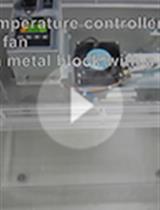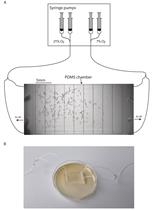- EN - English
- CN - 中文
Plate Assay to Determine Caenorhabditis elegans Response to Water Soluble and Volatile Chemicals
平板分析法检测秀丽隐杆线虫对水溶性和挥发性化学物质的反应
发布: 2018年02月20日第8卷第4期 DOI: 10.21769/BioProtoc.2740 浏览次数: 9010
评审: Gert JansenYan WangAnonymous reviewer(s)
Abstract
The nematode Caenorhabditis elegans is widely used for behavioral studies ranging from simple chemosensation to associative learning and memory. It is vital for such studies to determine optimal concentrations of attractive and aversive chemicals that C. elegans can sense. Here we describe a resource localization assay in which a chemical compound of interest is placed in two compartments of a quadrant plate in order to determine optimal concentrations of the chemical in behavioral studies. Using the assay, we determined the optimal concentration of a water-soluble attractant, KCl, as an unconditioned stimulus for the study of associative learning and memory. In this protocol, we also describe a chemotaxis assay using a square agar plate spotted with an aversive olfactory cue, 1-nonanol, as a conditioned stimulus.
Keywords: Attractant (引诱)Background
The nematode Caenorhabditis elegans has extensively been used as a model organism for the study of animal behaviors. C. elegans senses a variety of water-soluble and volatile chemicals that are mainly mediated by amphids, the largest chemosensory organs (Ward, 1973; Dusenbery, 1974; Bargmann and Horvitz, 1991; Bargmann et al., 1993). It is essential for the behavioral study to determine precise concentrations of chemicals that can be sensed by C. elegans. To determine optimal concentrations of water-soluble attractants for C. elegans, Wicks et al. (2000) used a quadrant agar plate for the behavioral assay in which a chemical of interest was mixed with agar in two compartments and this assay has widely been used for many chemicals (e.g., Jansen et al., 2002; Ortiz et al., 2009; Murayama and Maruyama, 2013; Sassa et al., 2013). Chemotaxis assay has also been used to measure the sensitivity of C. elegans to volatile compounds spotted on an agar plate (Bargmann et al., 1993; Troemel et al., 1997). C. elegans is also an excellent model organism for the study of associative learning and memory, in which water-soluble chemicals and volatile chemicals were used as an unconditioned stimulus (US) and a conditioned stimulus (CS) (Amano and Maruyama, 2011; Nishijima and Maruyama, 2017). For effective conditioning of worms, concentrations of CS and US are crucial parameters. The resource localization assay with quadrant agar plates and a chemotaxis assay on square agar plates were successfully used to define optimal concentrations of US and CS for the study of learning and memory. Therefore, these assays could be applied for many other attractive and repulsive chemicals in C. elegans behavioral analysis.
Materials and Reagents
- Latex gloves
- 1.5 ml plastic tubes, sterile (Eppendorf, catalog number: 0030123328 )
- 1.0 ml pipette tips, sterile (Thermo Fisher Scientific, Thermo Scientific, catalog number: H-111-R100NS-Q )
- 0.2 ml pipette tips, sterile (Quality Scientific Plastics, Thermo Fisher Scientific, Thermo Scientific, catalog number: TTW110RS-Q )
- 10 ml Serological pipettes, sterile (As One, catalog number: 2-5237-04 )
- 50 ml Serological pipettes, sterile (As One, catalog number: 2-5237-06 )
- Bottle top 0.2-µm filter units, sterile (Thermo Fisher Scientific, Thermo Scientific, catalog number: 566-0020 )
- Combitips advanced 50 ml, sterile (Eppendorf, catalog number: 0030089480 )
- Petri dishes, sterile (Kord-Valmark, catalog number: 2901 )
- Quadrant Petri dishes, sterile (Kord-Valmark, catalog number: 2913 )
- Square Petri dishes with grids, sterile (Simport, catalog number: D210-16 )
- Wild-type C. elegans strain N2 (available at Caenorhabditis Genetics Center [CGC], https://cbs.umn.edu/cgc/home)
- E. coli OP50 (available at Caenorhabditis Genetics Center [CGC], https://cbs.umn.edu/cgc/home)
- 1-Nonanol (Sigma-Aldrich, catalog number: 131210-100ML )
- Ethanol (99.5%) (Wako Pure Chemical Industries, catalog number: 057-00451 )
- Chloroform (Nacalai Tesque, catalog number: 08401-65 )
- LB medium capsules (MP Biomedical, catalog number: 3002-021 )
- Sodium chloride (NaCl) (Nacalai Tesque, catalog number: 31320-05 )
- Bacto agar (BD, catalog number: 214010 )
- Bacto peptone (BD, catalog number: 211677 )
- Potassium dihydrogen phosphate (KH2PO4) (Nacalai Tesque, catalog number: 28721-55 )
- Di-potassium hydrogen phosphate (K2HPO4) (Nacalai Tesque, catalog number: 28726-05 )
- HEPES (Nacalai Tesque, catalog number: 17514-15 )
- Sodium hydroxide (NaOH) (Wako Pure Chemical Industries, catalog number: 198-13765 )
- Calcium chloride dihydrate (CaCl2·2H2O) (Nacalai Tesque, catalog number: 06730-15 )
- Magnesium sulfate heptahydrate (MgSO4·7H2O) (Nacalai Tesque, catalog number: 21003-75 )
- Potassium chloride (KCl) (Nacalai Tesque, catalog number: 28514-75 )
- D-sorbitol (Sigma-Aldrich, catalog number: S1876-1KG )
- Gelatin (Wako Pure Chemical Industries, catalog number: 073-06295 )
- Cholesterol (Wako Pure Chemical Industries, catalog number: 034-03002 )
- LB broth (see Recipe 1)
- NGM plates (see Recipe 2)
- 1.0 M potassium phosphate (pH 6.0) (see Recipe 3)
- 1.0 M HEPES-NaOH (pH 7.2) (see Recipe 4)
- 1.0 M CaCl2 (see Recipe 5)
- 1.0 M MgSO4 (see Recipe 6)
- Agar for resource localization assay plates (see Recipe 7)
- 2.0% Molten agar (see Recipe 8)
- 0.25% Aqueous gelatin solution (see Recipe 9)
- 5.0 mg/ml cholesterol (see Recipe 10)
- Chemotaxis assay plates (see Recipe 11)
- Doubly deionized water (ddH2O; see Recipe 12)
Equipment
- Safety goggles
- A laboratory coat
- Worm pick
- Dental burner (Phoenix-Dent, model: APT-3 )
- Bunsen burner (EISCO)
- Incubator (SANYO, model: MIR-553 )
- Heating magnetic stirrer (Thermo Fisher Scientific, Thermo Scientific, model: SP131324 )
- Magnetic stirrer bar
- 1.0 L beaker
- Pipet-Aid® XP (Drummond Scientific, model: Pipet-Aid® XP, catalog number: 4-000-101 )
- Multipette M4 (Eppendorf, catalog number: 4982000012 )
- P20 pipetman (Gilson, catalog number: F123600 )
- P100 pipetman (Gilson, catalog number: F123615 )
- P1000 pipetman (Gilson, catalog number: F123602 )
- Kimwipes S-200 (Nippon Paper Crecia, catalog number: 62011 )
- Osmometer (Gonotec, model: Osmomat 030-D )
- Autoclave (Tomy Digital Biology, model: SX-300 )
- Aspirator
- Stereomicroscope (Olympus, model: SZX16 )
- Water purification system (Merck, model: Elix® Essential 10 UV )
- Water purification system (Merck, model: Milli-Q® Synthesis A10® )
Procedure
文章信息
版权信息
© 2018 The Authors; exclusive licensee Bio-protocol LLC.
如何引用
Murayama, T. and Maruyama, I. N. (2018). Plate Assay to Determine Caenorhabditis elegans Response to Water Soluble and Volatile Chemicals. Bio-protocol 8(4): e2740. DOI: 10.21769/BioProtoc.2740.
分类
神经科学 > 行为神经科学 > 趋化性
您对这篇实验方法有问题吗?
在此处发布您的问题,我们将邀请本文作者来回答。同时,我们会将您的问题发布到Bio-protocol Exchange,以便寻求社区成员的帮助。
Share
Bluesky
X
Copy link













